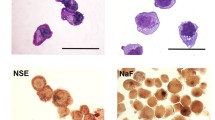Summary
Two single cell clones, CL3 and CL7, were developed from T24 cells. CL3 had abundant cytoplasmic granules, while CL7 did not have as much. CL3 and CL7 exhibited a modal number of chromosomes at 69 and 74, respectively. CL7 had a higher growth rate than CL3, as indicated by in vitro cell growth, plating efficiency, and growth of the tumors produced in nude mice. CL3 was slightly susceptible to adriamycin toxicity as compared to CL7.
Similar content being viewed by others
References
Bubeník J, Barešová M, Vilický V, Jakoubková J, Sainerová H, Donner J (1973) Established cell line of urinary bladder carcinoma (T24) containing tumor-specific antigen. Int J Cancer 11:765–773
Fingert HJ, Kindy RL, Pardee AB (1984) Enhanced lethality by methylxanthines in human bladder cancer cells treated with thiotepa. J Urol 132:609–613
Kato T, Ishikawa K, Nemoto R, Senoo A, Amano Y (1978) Morphological characterization of two established cell lines, T24 and MGH-U1, derived from human urinary bladder carcinoma. Tohoku J Exp Med 124:339–349
Malkovský M, Bubeník J (1977) Human urinary bladder carcinoma cell line (T24) in longterm culture: Chromosomal studies on a wild population and derived sublines. Neoplasma 24:319–326
Masuji H, Nakabayashi H, Sato J (1974) Long-term cultivation of two diploid epithelial cell lines derived from normal rat liver cells. Acta Med Okayama 28:281–293
Matsumura Y, Ozaki Y, Ohmori H, Okayama Urological Cancer Collaborating Group (OUCCG) (1983) Intravesical adriamycin chemotherapy in bladder cancer. Cancer Chemother Pharmacol [Suppl] 11:69–73
Nemoto R (1983) Chemosensitivity in vitro and clinical response to the selected drug. In: Prout GR, Tazaki H (eds) New concepts of bladder cancer. Etiology/biology, diagnosis, and management. Medical Research Center, Tokyo p 93
Ozaki Y (1977) Bladder instillation of adriamycin in the treatment of bladder tumors. Report 1: Clinical results. Jpn J Urol 68:934–944 (in Japanese)
Simpson WG, Tseng MT, Andersson KC, Harty JI (1984) Verapamil enhancement of chemotherapeutic efficacy in human bladder cancer cells. J Urol 132:574–576
Tokiwa T, Nakabayashi H, Miyazaki M, Sato J (1979) Isolation and characterization of diploid clones from adult and newborn rat liver cell lines. In Vitro 15:393–400
Tsushima T (1985) Fundamental studies on intravesical instillation of 4′-epi-adriamycin for treatment of bladder cancer. Acta Urol Jpn 31:1945–1956 (in Japanese)
Yoshimoto J, Matsumura Y, Tanahashi T, Ohmori H, Tokiwa T, Sato J (1982) Effects of steroid sex hormones and adriamycin on human bladder cancer cells in cuture. Acta Med Okayama 36:61–66
Author information
Authors and Affiliations
Rights and permissions
About this article
Cite this article
Tsushima, T., Tokiwa, T., Matsumura, Y. et al. Isolation of clones from T24 cells and test of their sensitivity to adriamycin. Res. Exp. Med. 188, 239–246 (1988). https://doi.org/10.1007/BF01852272
Received:
Accepted:
Issue Date:
DOI: https://doi.org/10.1007/BF01852272




